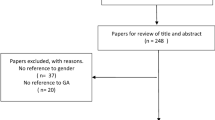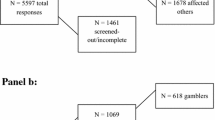Abstract
Exploratory data from both structured and unstructured interviews with members of Alcoholics Anonymous and Gamblers Anonymous, as well as additional data from previous observations, suggest that the recovery rate of A.A. is higher than that of G.A.. Since the programs are virtually the same an examination of the social context of the labeling process reveals that the more readily available use of the medical model for both the alcoholic and the significant others of the alcoholic are likely significant differences between the compulsive gambler and the compulsive drinker.
Similar content being viewed by others
References
The Addict: Even When You Win You Lose. (1983, May 3).U. S. News and World Report, p. 31.
Alcoholics Anonymous. (1976).Alcoholics Anonymous: Big Book. New York: Alcoholics Anonymous World Service.
Alcoholics Anonymous. (1984, October).Alcoholics Anonymous Grapevine.
American Psychiatric Association. (1980).Diagnostic and Statistical Manual of Mental Disorders Third Edition. Washington, D.C.: APA.
Axtelm, P. (1983, April 25). All-American In Trouble.Newsweek, pp. 81–82.
Carlton, P. (1983, June).Prospects for Clinical Research on Pathological Gambling. Paper presented at Carrier Foundation training conference on pathological gambling, Atlantic City.
Conrad, P. (1980).Deviance and Medicalization: From Badness to Sickness. St. Louis: C. V. Mosby Company.
Custer, R. L., & Custer, L. F. (1978, December).Characteristics of the Recovering Compulsive Gambler: A Survey of 150 Members of Gamblers Anonymous. Paper presented at the Fourth Annual Conference on Gambling, Reno.
Davis, F. (1960). Comment on “Initial Interaction of Newcomers in Alcoholics Anonymous.” Social Problems,8(4), 364–365.
Gamblers Anonymous. (1974).Gamblers Anonymous: Big Book. Los Angeles, California: Gamblers Anonymous Publishing Company.
Gambling Rage Out of Control? (1983, May 3).U. S. News and World Report, pp. 27–30.
Goode, E. (1984).Deviant Behavior (2nd ed). Englewood Cliffs, N.J.: Prentice-Hall.
Lesieur, H. R. (In press).The Chase: Career of the Compulsive Gambler. Cambridge: Schenkman.
Lesieur, H. R., & Custer, R. L. (1984). Pathological Gambling: Roots, Phases and Treatment.Annals of the American Academy of Political and Social Sciences. 474 (July), 146–156.
Lesieur, H. R. (1984, April 27). Personal communication.
Lewis, A. B. (1983, June). A Gamble Insurers Can't Afford.Newsletter of The National Council on Compulsive Gambling, pp. 1; 3.
Lofland, J. (1960). Reply to Davis' Comment on “Initial Interaction.”Social Problems, 8(4), 365–367.
Lofland, J. F., & Lejeune, R. A. (1960). Initial Interaction of Newcomers in Alcoholics Anonymous: A Field Experiment in Class Symbols and Communication.Social Problems, 8 pp. 102–111.
Looney, D. S. (1983, May 30). A Big Loss for a Gambling Quarterback.Sports Illustrated, pp. 30–31.
Mant, A. & Darroch, D. B. (1975). Media Images and Medical Images.Social Science and Medicine, 9 291–293.
Mead, G. H. (1934).Mind, Self, and Society. Chicago: The University of Chicago Press.
Mulford, H., & Miller, D. Measuring Public Acceptance of the Alcoholic as a Sick Person.Quarterly Journal of Studies on Alcohol, 25, 314–323.
Parsons, T. (1951).The Social System. Glencoe: The Free Press.
Preston, F. W. (1975, April).A Grounded Re-examination of Alcoholics Anonymous. Paper presented at the meetings of The Pacific Sociological Association, Victoria, British Columbia.
Preston, F. W., & Smith, R. W. (1975, June).Types and Treatments of Compulsive Gambling: Transferring the A.A. Paradigm. Paper presented at the Second Annual Conference on Gambling, Lake Tahoe.
Riesman, D. (1950).The Lonely Crowd. New Haven: Yale University Press.
Scheff, T. J. (1984).Being Mentally Ill, (2nd ed.). Aldine Publishing Company.
Szasz, T. (1974).Ceremonial Chemistry. Carden City, New York: Anchor Press/Doubleday.
Taber, J. I. (1984).Pathological Gambling Treatment Directory of Institutional and Non-profit Resources. Unpublished manuscript. (Available from Julian I. Taber, Coordinator, Gambling Treatment Program, Brecksville V.A.M.C., 10,000 Brecksville Road, Brecksville, OH 44141).
Taber, J. I. (1984).The “Brecksville” Program For The Treatment of Compulsive Gambling. Unpublished manuscript. (Available from Julian I. Taber, Coordinator, Gambling Treatment Program, Brecksville V.A.M.C., 10,000 Brecksville Road, Brecksville, OH 44141).
Trice, H. M. (1956). The “Outsider's” Role in Field Study.Sociology and Social Research, 41 27–32.
Trice, H. M., & Roman, P. M. (1970). Delabeling, Relabeling, and Alcoholics Anonymous.Social Problems, 17 (IV), 538–546.
Vaillant, G. E. (1983).The Natural History of Alcoholism: Causes, Patterns and Paths to Recovery. Cambridge, Mass.: Harvard University Press.
Waldron, I. (1977). Increased Prescribing of Valium, Librium and Other Drugs. An Example of the Influence of Economic and Social Factors on the Practice of Medicine.International Journal of Health Services, 7 37–62.
Whyte, W. H. (1956).The Organization Man. New York: Simon & Schuster.
Wiseman, J. P. (1970).Stations of the Lost. Englewood Cliffs, N.J.: Prentice-Hall.
Zimmerman, P., & Looney, D. S. (1983, April 18). Has It All Been Thrown Away?Sports Illustrated 40–42; 47.
Zola, I. (1972). Medicine as an Institution of Social Control.Sociological Review, 20 487–504.
Author information
Authors and Affiliations
Additional information
An embryonic version of this paper was presented at the Second Annual Conference on Gambling, Lake Tahoe, August 1975. The authors thank Henry Lesieur, Robert Custer, and the anonymous reviewers ofThe Journal of Gambling Behavior for their comments and suggestions. We give special thanks to Dan, Howie, Jeanne, Berdell, Barbara, John, Swede, Happy Jack, Nancy, Skip, and many other anonymous members of G.A. and A.A. for their help and cooperation in this study.
Rights and permissions
About this article
Cite this article
Preston, F.W., Smith, R.W. Delabeling and relabeling in Gamblers Anonymous: Problems with transferring the Alcoholics Anonymous paradigm. J Gambling Stud 1, 97–105 (1985). https://doi.org/10.1007/BF01019862
Issue Date:
DOI: https://doi.org/10.1007/BF01019862




